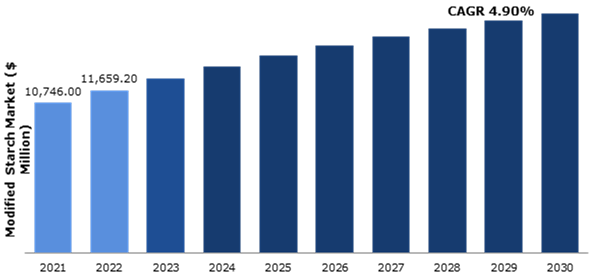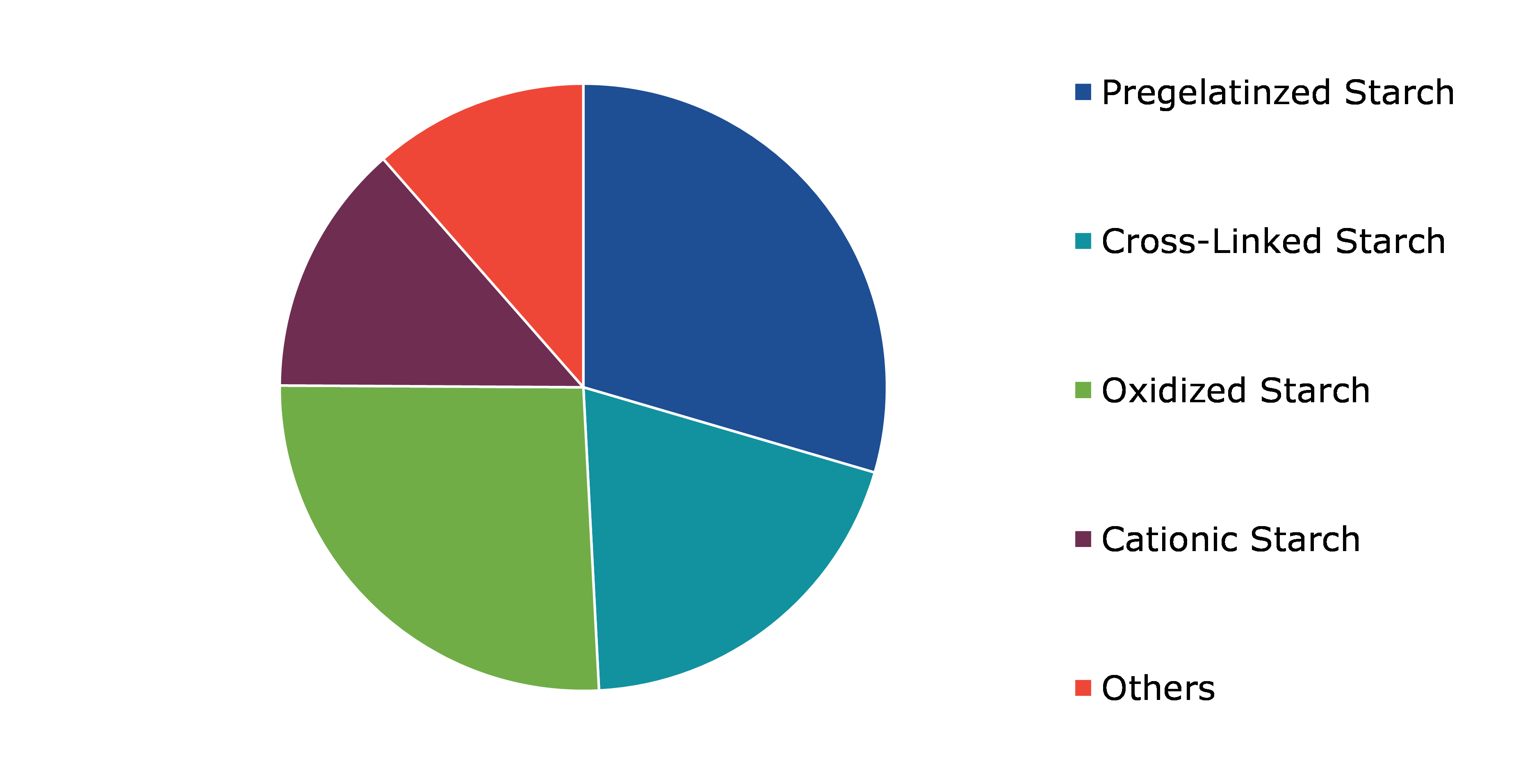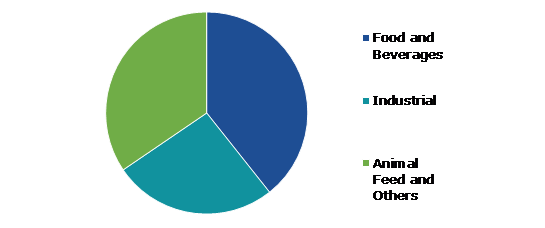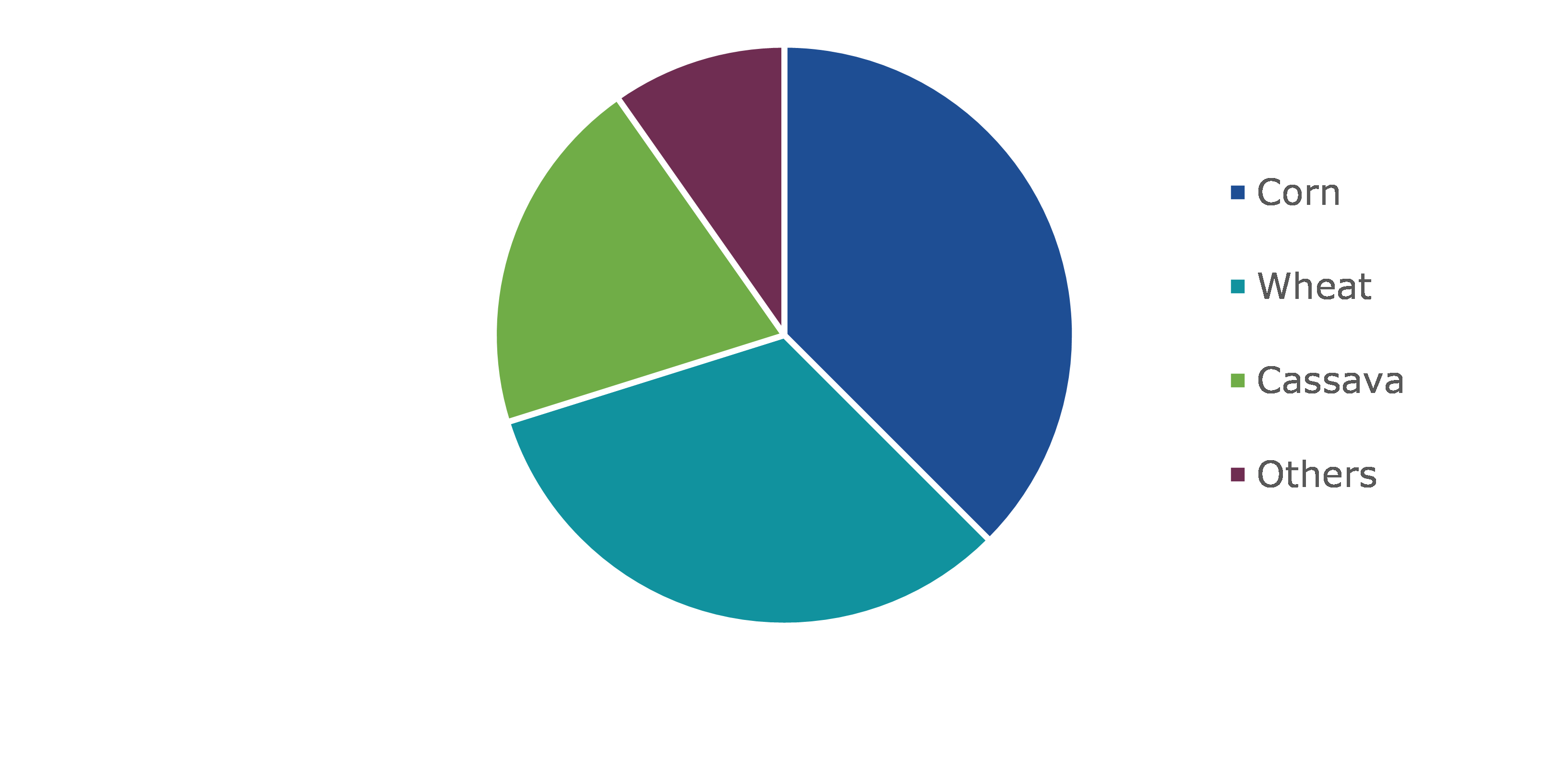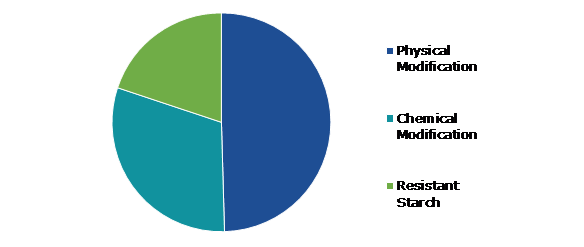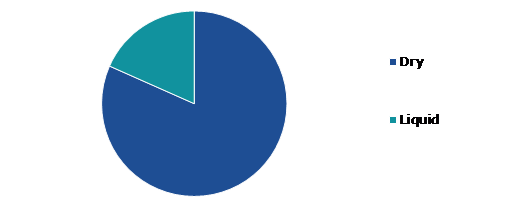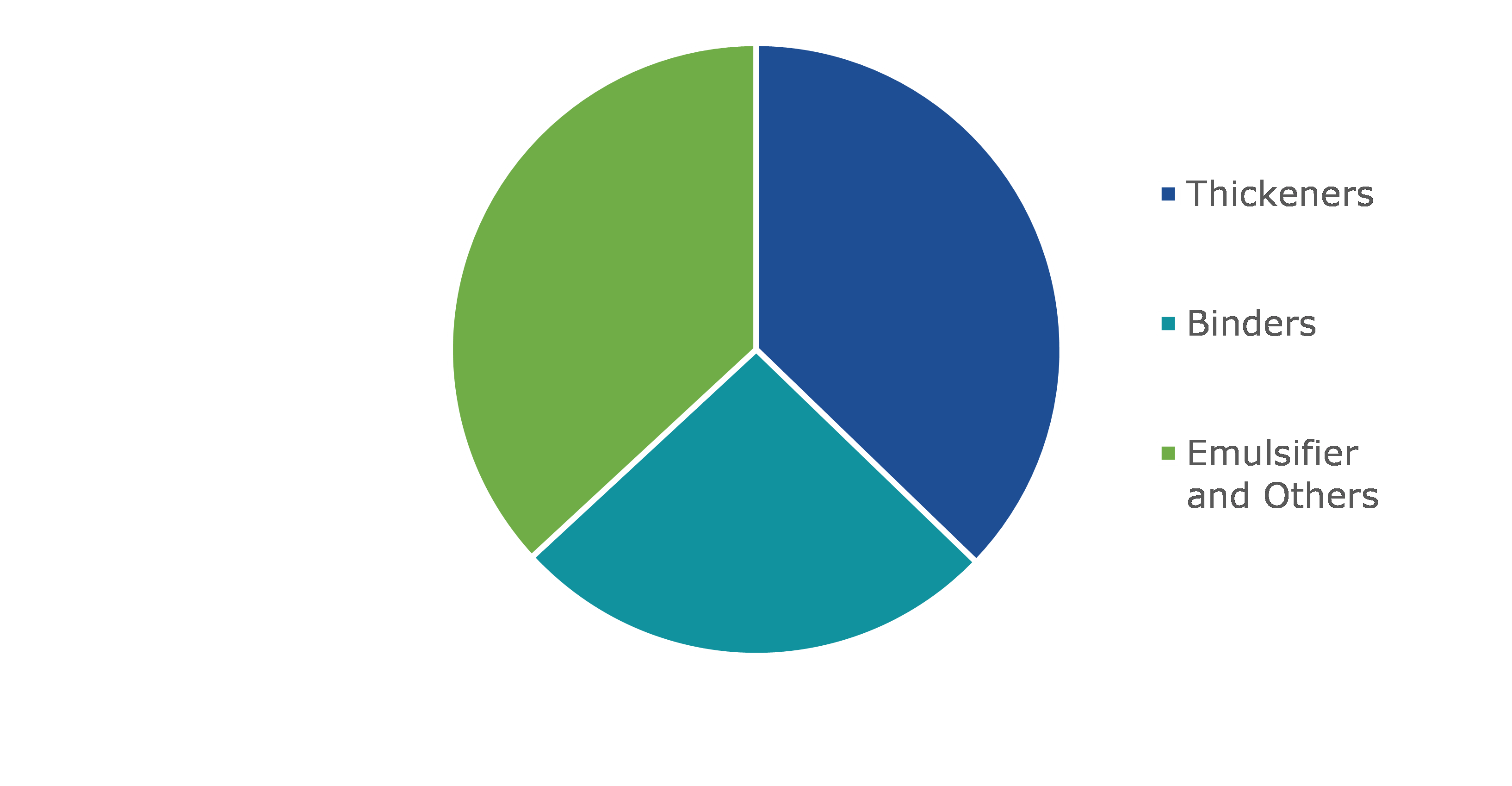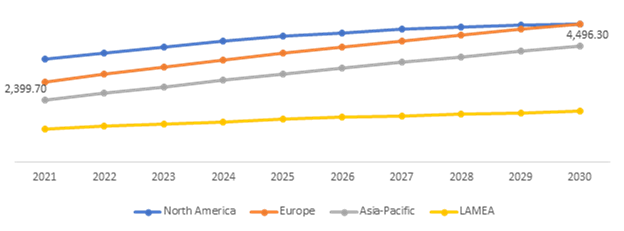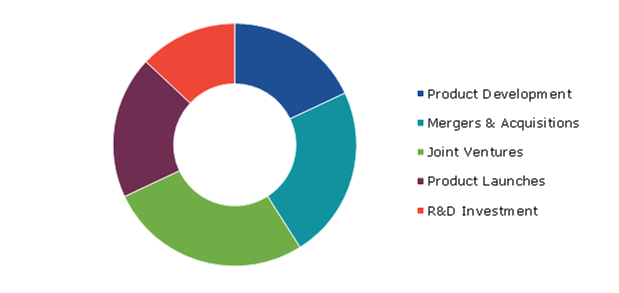Modified Starch Market Report
RA04297
Modified Starch Market by Type (Cationic Starch, Cross-linked Starch, Oxidized Starch, Pregelatinized Starch, and Others), Applications (Food & Beverages, Industrial, and Animal Feed & Others), Raw Materials (Corn, Cassava, Wheat, and Others), Production Method (Physical Modification, Chemical Modification, and Resistant Starch), Form (Dry and Liquid), Function (Thickeners, Binders, and Emulsifiers & Others), Sales Channel (Online and Offline), and Regional Analysis (North America, Europe, Asia-Pacific, and LAMEA): Global Opportunity Analysis and Industry Forecast, 2021-2030
Global Modified Starch Market Analysis
The global modified starch market share was valued at $10,746.60 million in 2021, and is projected to grow at a CAGR of 4.90%, by generating a revenue of $17,141.70 million by 2030.
Global Modified Starch Market Synopsis
Modified starch is widely used in manufacturing of various food products as its functional qualities are considerably better over native starch. Heat-moisture treatment and annealing are two physical modification methods that change starch granules without destroying or gelatinizing them. In the food sector, modified starch is used as a fat substitute, texture enhancer, and taste encapsulator.
Modified starch can also be used as a stabilizing agent, thickening agent, and dough binding agent. Apart from the cosmetics and pet food industries, modified starch's primary applications include in the food, paper, and pharmaceutical sectors, as well as the textile industry. Some types of modified starch are thin boiling starch, yellow starch, white starch, oxidized starch, and cationic starch.
Rising raw material costs is anticipated to restrain the modified starch market revenue growth in the upcoming years. Due to its characteristics, modified starch is employed in a variety of applications, however extraction methods are limited. Modified starch is made with starch derived from wheat, corn, rice, and cassava. Increased demand for modified starch in the animal feed, food & beverages, cosmetics, medicines, and paper industry results in high raw material prices.
Over the last few years, there has been a significant increase in global demand for modified starch. Modified starch for cosmetics and personal care products is designed to meet special needs of consumers. After application, tanning products should be more resistant to sand adhesion to the skin. As a result, the global modified starch market is predicted to grow through 2030, as its application in cosmetics and personal care products increases.
According to regional analysis, the North America modified starch market is predicted to have the most dominant market share by 2030.
Global Modified Starch Overview
Modified starch has witnessed major demand across the globe in recent years outlook. Producing an effective and natural cosmetic product while considering the users’ comfort is a challenge. For example, customers may like a high amount of natural oils but not necessarily heavy occlusive coating that remains after application. As a result, the demand for modified starch is expected to increase during the forecast period, owing to its increasing application in cosmetics and personal care products.
Demand for modified starch is driven by wide range of application of modified starch in the food industry. For instance, modified starch has a number of functional advantages in various food products, including baked goods, snacks, beverages, and nutritional foods. Rising consumer demand for healthier food options is expected to boost demand for modified starch during the forecast period.
COVID-19 Impact Analysis on the Modified Starch Market
The COVID-19 impact on modified starch market had both positively as well as negatively impacted modified starch market. The spread of COVID-19 was witnessed in top raw material producing countries such as China, India, Europe, Russia, the U.S., Ukraine, and others, which led to lockdowns to combat the pandemic. As a result of the lack of labor, production of these crops was significantly hampered. All these raw material shortages and production delays greatly affected availability and demand for modified starch during the pandemic. Due to reduced output of raw material crops, interrupted supply chains, and limited international trade, manufacturers of modified starch experienced raw material shortage. Food & beverages, animal feed, chemicals, paper, and pharmaceutical businesses decreased production or stopped completely. As these sectors are major users of modified starch, its demand also decreased.
However, COVID-19 pandemic witnessed a rise in the consumption of processed foods and other goods with extended shelf lives, which use modified starch for texture. Packaged food sales soared as consumers rushed to replenish their pantries during the lockdown. Self-cooking increased the use of modified starch products and the inclusion of starch in different food processors.
Increasing Investment in the Modified Starch Market to Help the Industry Development
As ingredient suppliers broaden their starch sources, they are focusing on baked goods advancements such sauces in frozen food meals and fruit filling in desserts. According to the European Starch Industry Association, overall starch output in Europe was $3,101.50 million in 2021, which includes wheat, maize, and potatoes. Wheat had been the most common source of starch, followed by corn and potato.
More crucially, a rising number of starch manufacturers are investing in the European starch and sweetener sector to help local economy and community while also preparing companies in the field for long-term success. As a result, increased investment in modified starch manufacturing to meet rising demand is expected to drive the market revenue growth over the forecast period.
To know more about global modified starch market drivers, get in touch with our analysts here.
Finite Sources of Modified Starch to Hamper the Market Growth
The sources from which starch is extracted are very limited, which include cassava, corn, wheat, and more. The production of these sources depends on climatic conditions. For instance, unfavorable climate hampers the overall production of cassava and leads to the fluctuation in the price of cassava. Also, these are not only used for manufacturing starch but for other purposes as well. A large amount of raw corn is used in the production of ethanol, which negatively impacts the food sector. The use of corn in ethanol production decreases its proportion in food as well as in many other non-food applications, especially as modified starch.
Rise in Number of Fast Food Restaurants is Anticipated to Boost the Market Revenue Growth
Fast food restaurants account for a significant sector of the food services business, and their popularity has increased over time as a result of their emphasis on competitive and low pricing, as well as rising consumer demand for convenience foods.
In recent years, fast food restaurant chains have increased in various parts of the globe, each with its unique cuisine and product offerings to fulfil consumer demand. Modified starch is widely used in fast food restaurants' food preparations to improve texture, flavor, and taste of their products. These factors are anticipated to boost revenue growth of the modified starch market in upcoming years.
Global Modified Starch Market, by Type
Based on type, the market has been classified into cationic starch, cross-linked starch, oxidized starch, pregelatinized starch, and others. Among these, pregelatinized starch sub-segment accounted for the highest market share in 2021 and it is estimated to have a dominating market share by 2030.
Global Modified Starch Market Share, by Type, 2021
Source: Research Dive Analysis
The pregelatinized starch sub-segment is expected to dominate the market share by 2030. It is a processed carbohydrate, which is used as a binder and/or texturizer. The most prevalent sources are maize, waxy corn, tapioca, and potatoes. It is dried, boiled, and grounded for using in a variety of industries. Pregelatinized starch comes in powder and flake form, allowing for increased viscosity in dishes. Baked products, soups, and infant meals are just a few examples. In the pharmaceutical and culinary sector, pregelatinized starch is a popular excipient as it dissolves and absorbs water quickly that aids digestion.
Pregelatinized starch also acts as a food stabilizer, allowing processed foods to last longer. As population is increasing across the globe, demand for pharmacological medicines and baby formula is also rising. The high CAGR of market over the projection period is attributed to increased popularity of baked goods around the world.
Global Modified Starch Market, by Applications
Based on applications, the market has been classified into food & beverages, industrial, and animal feed & others. Among these, food & beverages sub-segment accounted for the highest demand market share in 2021 and it is estimated to have a dominating market share by 2030.
Global Modified Starch Market Share, by Applications, 2021
Source: Research Dive Analysis
The food & beverages sub-segment is anticipated to have highest market share in the forecast time frame. Modified starches are good at thickening and absorbing water from other cooking liquids. This is why they are useful in dishes in which ingredients need to be bound or the texture thickened, such as soups, sauces, and baked goods. Starch is also used as a basis to produce alternatives to cane sugar, which are called glucose-fructose or fructose-glucose syrups. These syrups have a similar chemical composition to cane sugar and an almost identical taste. The advantage of syrups is that they come in a liquid form, unlike table sugar, which is crystallized, so they are easier to blend with other ingredients in creams, ice creams, drinks, and other liquid or semi-liquid foods, which further contributes to market revenue growth.
Global Modified Starch Market, by Raw Materials
Based on raw materials, the market has been classified into corn, cassava, wheat, and others. Among these, corn sub-segment accounted for the highest market share in 2021 and it is estimated to have a dominating market share by 2030.
Global Modified Starch Market Share, by Raw Materials, 2021
Source: Research Dive Analysis
The corn sub-segment is anticipated to have highest market share in the forecast time frame. Corn is a widespread staple food around the world due to its importance in people’s diets. Corn starch is also broadly used in a number of food applications, which further contributes to market revenue growth. Corn starch is often used to thicken soups, sauces, gravies, and custards.
Corn is dependent on a number of different genes that affect endosperm starch production, resulting in an increase in sugar content and a shift in polysaccharide composition. As a result, loss of function alleles is a common cause of such alterations.
Global Modified Starch Market, by Production Method
Based on production method, the market has been classified into physical modification, chemical modification, and resistant starch. Among these, physical modification sub-segment accounted for highest market share in 2021, and it is estimated to have a dominating market share by 2030.
Global Modified Starch Market, by Production Method, 2021
Source: Research Dive Analysis
The physical modification sub-segment is expected to garner the highest market share in the projected time period. It encompass the morphological and three-dimensional changes that occur to starch as a result of various physical influences, including moisture, milling, temperature, pH, pressure, radiation, ultrasonic waves, pulse-electric field, and others. Particle size, surface characteristics, solubility index, and functional features including starch's ability to bind water, swell when heated, paste, and gel when heated, are all affected by physical alterations.
Global Modified Starch Market, by Form
Based on form, the market has been classified into dry and liquid. Among these, the dry sub-segment accounted for the highest market share in 2021 and it is estimated to have a dominating market share during the forecast period.
Global Modified Starch Market Share, by Form, 2021
Source: Research Dive Analysis
The dry sub-segment is anticipated to generate the highest revenue by 2030. Drying of starch is done to produce roll-dried starch. It is applied to frozen food products. Dried starch offers a number of advantages such as high performance, additional convenience, dispensability, flexibility, and others. Rapid hydration, high processing tolerance, and long shelf life are requirements of the cold manufacturing process. Consumers want ready to cook food because of their busy lifestyles. In order to increase the nutritional value, add texture, and lengthen the shelf life of traditional foods, roll-dried starch is employed in their preparation. Food is preserved with roll-dried starch to keep it fresh and guard against damage while in transit and storage.
Global Modified Starch Market, by Function
Based on function, the market has been classified into thickeners, binders, and emulsifiers & others. Among these, the thickeners sub-segment accounted for highest market share in 2021 and it is estimated to have a dominating market share by 2030.
Global Modified Starch Market, by Function, 2021
Source: Research Dive Analysis
The thickeners sub-segment is expected to dominate the market in the timeframe. The sub-segment includes food thickeners such as starch, hydrocolloids, and proteins, which are commonly employed as thickening, stabilizing, and gelling agents in the baking industry. Furthermore, rising demand for snacks, protein-rich goods, and nutritional foods is expected to drive the sub-segment demand in the coming years.
Global Modified Starch Market, by Sales Channel
Based on sales channel, the market has been classified into online and offline. Among these, the offline sub-segment accounted for highest market share in 2021 and it is estimated to have a dominating market share by 2030.
Global Modified Starch Market, by Sales Channel, 2021
Source: Research Dive Analysis
The offline sub-segment revenue growth is expected to increase during the analysis timeframe due to rising number of offline retail stores all across the globe. Preference for retail stores to purchase modified starch is increasing, as the customer expects a simple and instant shopping experience.
Global Modified Starch Market, Regional Insights:
The modified starch market was investigated across North America, Europe, Asia-Pacific, and LAMEA.
Global Modified Starch Market Size & Forecast, by Region, 2021-2030 (USD Million)
Source: Research Dive Analysis
The Market for Modified Starch in Asia-Pacific Continues to be the Fastest Growing
In Asia-Pacific, modified starch is used for a variety of applications as it thickens and stabilizes food preparations, particularly sauces, which is expected to drive revenue growth of the market. The industrial starches industry is developing as a result of the growing market for sauces and condiments. Rising need of this region for starch has been fueled by increasing manufacturing industries ranging from food & beverages to cosmetics. In nations such as China and India, the fast-developing processed food sector and consumer shift towards snacking have been driving revenue growth of the modified starch market. The changing retail landscape, as well as engagement of various global and local players in the prepared food industry, is expected to drive demand for modified starches in the region.
Global Competitive Scenario in the Global Modified Starch Market
Product launches and mergers & acquisitions are the most common strategies followed by major players operating in the market. On June 29, 2021, Ulrick & Short, launched new clean-label flour for gluten free bakery. Moreover, the company aimed specifically at improving viscosity, structure, and texture of gluten free bakery products. It has been produced considering the bakery applications and to improve the moisture, softness, and structure in a range of products made using it.
Source: Research Dive Analysis
Some of the leading modified starch market players are Ulrick and Short Ltd., Penford Corp., SPACSTARCH PRODUCTS (INDIA) LTD., Tirupati Starch & Chemicals Ltd., Angel Starch & Food Pvt Ltd., Honest Derivatives Pvt. Ltd., Sanstar Bio - Polymers Ltd., Shubham Starch Chem (P) Ltd., AGRANA Strke GmbH., and Everest Starch (IND) Pvt. Ltd.
| Aspect | Particulars |
| Historical Market Estimations | 2020-2021 |
| Base Year for Market Estimation | 2021 |
| Forecast Timeline for Market Projection | 2021-2030 |
| Geographical Scope | North America, Europe, Asia-Pacific, and LAMEA |
| Segmentation by Raw Materials |
|
| Segmentation by Production Method |
|
| Segmentation by Form |
|
| Segmentation by Type |
|
| Segmentation by Applications |
|
| Segmentation by Function |
|
| Segmentation by Sales Channel |
|
| Key Companies Profiled |
|
Q1. What is the size of the modified starch market?
A. The size of the modified starch market was over $10,746.60 million in 2021, and is projected to reach $17,141.70 million by 2030.
Q2. Which are the major companies in the modified starch market?
A. Ulrick and Short Ltd., Penford Corp., SPACSTARCH PRODUCTS (INDIA) LTD., Tirupati Starch & Chemicals Ltd., Angel Starch & Food Pvt Ltd., and Honest Derivatives Pvt. Ltd. are the major companies operating in modified starch market.
Q3. Which region, among others, possesses greater investment opportunities in the near future?
A. The Asia-Pacific region possesses greater investment opportunities for investors to witness the most promising growth in the future.
Q4. What will be the growth rate of the Asia-Pacific modified starch market?
A. Asia-Pacific modified starch market is anticipated to grow at 6.80% CAGR during the forecast period.
Q5. What are the strategies opted by the leading players in this market?
A. Agreement and investment are the two key strategies opted by the operating companies in this market.
Q6. Which companies are investing more on R&D practices?
A. Ulrick and Short Ltd., Penford Corp., SPACSTARCH PRODUCTS (INDIA) LTD., Tirupati Starch & Chemicals Ltd., Angel Starch & Food Pvt Ltd., Honest Derivatives Pvt. Ltd., Sanstar Bio - Polymers Ltd., Shubham Starch Chem (P) Ltd., AGRANA Strke GmbH., and Everest Starch (IND) Pvt. Ltd. are companies investing more on R&D practices.
1.Research Methodology
1.1.Desk Research
1.2.Real time insights and validation
1.3.Forecast model
1.4.Assumptions and forecast parameters
1.5.Market size estimation
1.5.1.Top-down approach
1.5.2.Bottom-up approach
2.Report Scope
2.1.Market definition
2.2.Key objectives of the study
2.3.Report overview
2.4.Market segmentation
2.5.Overview of the impact of COVID-19 on Global modified starch market
3.Executive Summary
4.Market Overview
4.1.Introduction
4.2.Growth impact forces
4.2.1.Drivers
4.2.2.Restraints
4.2.3.Opportunities
4.3.Market value chain analysis
4.3.1.List of raw material suppliers
4.3.2.List of manufacturers
4.3.3.List of distributors
4.4.Innovation & sustainability matrices
4.4.1.Technology matrix
4.4.2.Regulatory matrix
4.5.Porter’s five forces analysis
4.5.1.Bargaining power of suppliers
4.5.2.Bargaining power of consumers
4.5.3.Threat of substitutes
4.5.4.Threat of new entrants
4.5.5.Competitive rivalry intensity
4.6.PESTLE analysis
4.6.1.Political
4.6.2.Economical
4.6.3.Social
4.6.4.Technological
4.6.5.Environmental
4.7.Impact of COVID-19 on modified starch market
4.7.1.Pre-covid market scenario
4.7.2.Post-covid market scenario
5.Modified Starch Market, by Type
5.1.Overview
5.1.1.Market size and forecast, by Type
5.2.Cationic Starch
5.2.1.Key market trends, growth factors, and opportunities
5.2.2.Market size and forecast, by region, 2022-2030
5.2.3.Market share analysis, by country 2022 & 2030
5.3.Pregelatinized Starch
5.3.1.Key market trends, growth factors, and opportunities
5.3.2.Market size and forecast, by region, 2022-2030
5.3.3.Market share analysis, by country 2022 & 2030
5.4.Cross-Linked Starch
5.4.1.Key market trends, growth factors, and opportunities
5.4.2.Market size and forecast, by region, 2022-2030
5.4.3.Market share analysis, by country 2022 & 2030
5.5.Oxidized Starch
5.5.1.Key market trends, growth factors, and opportunities
5.5.2.Market size and forecast, by region, 2022-2030
5.5.3.Market share analysis, by country 2022 & 2030
5.6.Other
5.6.1.Key market trends, growth factors, and opportunities
5.6.2.Market size and forecast, by region, 2022-2030
5.6.3.Market share analysis, by country 2022 & 2030
5.7.Research Dive Exclusive Insights
5.7.1.Market attractiveness
5.7.2.Competition heatmap
6.Modified Starch Market, by Applications
6.1.Overview
6.1.1.Market size and forecast, by Application
6.2.Food & Beverages
6.2.1.Key market trends, growth factors, and opportunities
6.2.2.Market size and forecast, by region, 2022-2030
6.2.3.Market share analysis, by country 2022 & 2030
6.3.Animal Feed and Others
6.3.1.Key market trends, growth factors, and opportunities
6.3.2.Market size and forecast, by region, 2022-2030
6.3.3.Market share analysis, by country 2022 & 2030
6.4.Industrial
6.4.1.Key market trends, growth factors, and opportunities
6.4.2.Market size and forecast, by region, 2022-2030
6.4.3.Market share analysis, by country 2022 & 2030
6.5.Research Dive Exclusive Insights
6.5.1.Market attractiveness
6.5.2.Competition heatmap
7.Modified Starch Market, by Raw Materials
7.1.Overview
7.1.1.Market size and forecast, by Raw Material
7.2.Corn
7.2.1.Key market trends, growth factors, and opportunities
7.2.2.Market size and forecast, by region, 2022-2030
7.2.3.Market share analysis, by country 2022 & 2030
7.3.Cassava
7.3.1.Key market trends, growth factors, and opportunities
7.3.2.Market size and forecast, by region, 2022-2030
7.3.3.Market share analysis, by country 2022 & 2030
7.4.Wheat
7.4.1.Key market trends, growth factors, and opportunities
7.4.2.Market size and forecast, by region, 2022-2030
7.4.3.Market share analysis, by country 2022 & 2030
7.5.Others
7.5.1.Key market trends, growth factors, and opportunities
7.5.2.Market size and forecast, by region, 2022-2030
7.5.3.Market share analysis, by country 2022 & 2030
7.6.Research Dive Exclusive Insights
7.6.1.Market attractiveness
7.6.2.Competition heatmap
8.Modified Starch Market, by Function
8.1.Overview
8.1.1.Market size and forecast, by Function
8.2.Thickeners
8.2.1.Key market trends, growth factors, and opportunities
8.2.2.Market size and forecast, by region, 2022-2030
8.2.3.Market share analysis, by country 2022 & 2030
8.3.Binders
8.3.1.Key market trends, growth factors, and opportunities
8.3.2.Market size and forecast, by region, 2022-2030
8.3.3.Market share analysis, by country 2022 & 2030
8.4.Emulsifier and Others
8.4.1.Key market trends, growth factors, and opportunities
8.4.2.Market size and forecast, by region, 2022-2030
8.4.3.Market share analysis, by country 2022 & 2030
8.5.Research Dive Exclusive Insights
8.5.1.Market attractiveness
8.5.2.Competition heatmap
9.Modified Starch Market, by Region
9.1.North America
9.1.1.U.S.
9.1.1.1.Market size analysis, by Type
9.1.1.2.Market size analysis, by Applications
9.1.1.3.Market size analysis, by Raw Material
9.1.1.4.Market size analysis, by Function
9.1.2.Canada
9.1.2.1.Market size analysis, by Type
9.1.2.2.Market size analysis, by Applications
9.1.2.3.Market size analysis, by Raw Material
9.1.2.4.Market size analysis, by Function
9.1.3.Mexico
9.1.3.1.Market size analysis, by Type
9.1.3.2.Market size analysis, by Applications
9.1.3.3.Market size analysis, by Raw Material
9.1.3.4.Market size analysis, by Function
9.1.4.Research Dive Exclusive Insights
9.1.4.1.Market attractiveness
9.1.4.2.Competition heatmap
9.2.Europe
9.2.1.Germany
9.2.1.1.Market size analysis, by Type
9.2.1.2.Market size analysis, by Applications
9.2.1.3.Market size analysis, by Raw Material
9.2.1.4.Market size analysis, by Function
9.2.2.U.K.
9.2.2.1.Market size analysis, by Type
9.2.2.2.Market size analysis, by Applications
9.2.2.3.Market size analysis, by Raw Material
9.2.2.4.Market size analysis, by Function
9.2.3.France
9.2.3.1.Market size analysis, by Type
9.2.3.2.Market size analysis, by Applications
9.2.3.3.Market size analysis, by Raw Material
9.2.3.4.Market size analysis, by Function
9.2.4.Spain
9.2.4.1.Market size analysis, by Type
9.2.4.2.Market size analysis, by Applications
9.2.4.3.Market size analysis, by Raw Material
9.2.4.4.Market size analysis, by Function
9.2.5.Italy
9.2.5.1.Market size analysis, by Type
9.2.5.2.Market size analysis, by Applications
9.2.5.3.Market size analysis, by Raw Material
9.2.5.4.Market size analysis, by Function
9.2.6.Rest of Europe
9.2.6.1.Market size analysis, by Type
9.2.6.2.Market size analysis, by Applications
9.2.6.3.Market size analysis, by Raw Material
9.2.6.4.Market size analysis, by Function
9.2.7.Research Dive Exclusive Insights
9.2.7.1.Market attractiveness
9.2.7.2.Competition heatmap
9.3.Asia-Pacific
9.3.1.China
9.3.1.1.Market size analysis, by Type
9.3.1.2.Market size analysis, by Applications
9.3.1.3.Market size analysis, by Raw Material
9.3.1.4.Market size analysis, by Function
9.3.2.Japan
9.3.2.1.Market size analysis, by Type
9.3.2.2.Market size analysis, by Applications
9.3.2.3.Market size analysis, by Raw Material
9.3.2.4.Market size analysis, by Function
9.3.3.India
9.3.3.1.Market size analysis, by Type
9.3.3.2.Market size analysis, by Applications
9.3.3.3.Market size analysis, by Raw Material
9.3.3.4.Market size analysis, by Function
9.3.4.Australia
9.3.4.1.Market size analysis, by Type
9.3.4.2.Market size analysis, by Applications
9.3.4.3.Market size analysis, by Raw Material
9.3.4.4.Market size analysis, by Function
9.3.5.South Korea
9.3.5.1.Market size analysis, by Type
9.3.5.2.Market size analysis, by Applications
9.3.5.3.Market size analysis, by Raw Material
9.3.5.4.Market size analysis, by Function
9.3.6.Rest of Asia-Pacific
9.3.6.1.Market size analysis, by Type
9.3.6.2.Market size analysis, by Applications
9.3.6.3.Market size analysis, by Raw Material
9.3.6.4.Market size analysis, by Function
9.3.7.Research Dive Exclusive Insights
9.3.7.1.Market attractiveness
9.3.7.2.Competition heatmap
9.4.LAMEA
9.4.1.Brazil
9.4.1.1.Market size analysis, by Type
9.4.1.2.Market size analysis, by Applications
9.4.1.3.Market size analysis, by Raw Material
9.4.1.4.Market size analysis, by Function
9.4.2.Saudi Arabia
9.4.2.1.Market size analysis, by Type
9.4.2.2.Market size analysis, by Applications
9.4.2.3.Market size analysis, by Raw Material
9.4.2.4.Market size analysis, by Function
9.4.3.UAE
9.4.3.1.Market size analysis, by Type
9.4.3.2.Market size analysis, by Applications
9.4.3.3.Market size analysis, by Raw Material
9.4.3.4.Market size analysis, by Function
9.4.4.South Africa
9.4.4.1.Market size analysis, by Type
9.4.4.2.Market size analysis, by Applications
9.4.4.3.Market size analysis, by Raw Material
9.4.4.4.Market size analysis, by Function
9.4.5.Rest of LAMEA
9.4.5.1.Market size analysis, by Type
9.4.5.2.Market size analysis, by Applications
9.4.5.3.Market size analysis, by Raw Material
9.4.5.4.Market size analysis, by Function
9.4.6.Research Dive Exclusive Insights
9.4.6.1.Market attractiveness
9.4.6.2.Competition heatmap
10.Competitive Landscape
10.1.Top winning strategies, 2021
10.1.1.By strategy
10.1.2.By year
10.2.Strategic overview
10.3.Market share analysis, 2021
11.Company Profiles
11.1.Ulrick and Short Ltd.
11.1.1.Overview
11.1.2.Business segments
11.1.3.Product portfolio
11.1.4.Financial performance
11.1.5.Recent developments
11.1.6.SWOT analysis
11.2.Penford Corp.
11.2.1.Overview
11.2.2.Business segments
11.2.3.Product portfolio
11.2.4.Financial performance
11.2.5.Recent developments
11.2.6.SWOT analysis
11.3.SPACSTARCH PRODUCTS (INDIA) LTD.
11.3.1.Overview
11.3.2.Business segments
11.3.3.Product portfolio
11.3.4.Financial performance
11.3.5.Recent developments
11.3.6.SWOT analysis
11.4.Tirupati Starch & Chemicals Ltd.
11.4.1.Overview
11.4.2.Business segments
11.4.3.Product portfolio
11.4.4.Financial performance
11.4.5.Recent developments
11.4.6.SWOT analysis
11.5.Angel Starch & Food Pvt Ltd.
11.5.1.Overview
11.5.2.Business segments
11.5.3.Product portfolio
11.5.4.Financial performance
11.5.5.Recent developments
11.5.6.SWOT analysis
11.6.Honest Derivatives Pvt. Ltd.
11.6.1.Overview
11.6.2.Business segments
11.6.3.Product portfolio
11.6.4.Financial performance
11.6.5.Recent developments
11.6.6.SWOT analysis
11.7.Sanstar Bio - Polymers Ltd.
11.7.1.Overview
11.7.2.Business segments
11.7.3.Product portfolio
11.7.4.Financial performance
11.7.5.Recent developments
11.7.6.SWOT analysis
11.8.Shubham Starch Chem (P) Ltd.
11.8.1.Overview
11.8.2.Business segments
11.8.3.Product portfolio
11.8.4.Financial performance
11.8.5.Recent developments
11.8.6.SWOT analysis
11.9.AGRANA Strke GmbH.
11.9.1.Overview
11.9.2.Business segments
11.9.3.Product portfolio
11.9.4.Financial performance
11.9.5.Recent developments
11.9.6.SWOT analysis
11.10.Everest Starch (IND) Pvt. Ltd.
11.10.1.Overview
11.10.2.Business segments
11.10.3.Product portfolio
11.10.4.Financial performance
11.10.5.Recent developments
11.10.6.SWOT analysis
12.Appendix
12.1.Parent & peer market analysis
12.2.Premium insights from industry experts
12.3.Related reports
Modified starch, also called as starch derivatives, are prepared by chemically, enzymatically, or physically treating native starch to change its properties. Modified starch is widely used in the food sector for manufacturing different food products and is a better alternative than native starch because of its great functional qualities. It’s mostly used as a fat substitute and thickeners in gravies, sauces, and custards. Besides, modified starch can also be used as a stabilizing agent, dough binding agent, and thickening agent and has significant applications in the cosmetics pet food industry too.
Forecast Analysis:
Increased investment in the modified starch manufacturing along with the growing number of starch manufacturers across the world are some factors anticipated to drive the growth of the global modified starch market during the forecast period. In addition, rising fast food restaurants across the globe along with people’s growing inclination towards convenient foods is estimated to create abundant market growth opportunities and further boost its revenue during the 2021-2030 analysis timeframe. However, increasing costs of raw materials and lack of resources are some factors to hamper the market growth.
Regionally, the modified starch market in the Asia-Pacific region is expected to witness better growth opportunities during the forecast years due to the wide applications of modified starch as thickeners in food preparations, especially sauces, gravies, and custards. Furthermore, growing markets for sauces and condiments along with surging demand for convenient food products in countries like India, China, and South Korea are some more factors to uplift the market growth in the Asia-Pacific region by 2030.
According to the report published by Research Dive, the global modified starch market is predicted to surpass $17,141.70 million and grow at 4.90% CAGR in the 2021–2030 timeframe. Some significant market players include SPACSTARCH PRODUCTS (INDIA) LTD., Tirupati Starch & Chemicals Ltd., Ulrick and Short Ltd., Sanstar Bio - Polymers Ltd., Penford Corp., Honest Derivatives Pvt. Ltd., Shubham Starch Chem (P) Ltd., Everest Starch (IND) Pvt. Ltd., Angel Starch & Food Pvt Ltd., AGRANA Strke GmbH., among others.
Covid-19 Impact on the Modified Starch Market:
The onset of the covid-19 pandemic has had a devastating impact on the global modified starch market due to reduced production of wheat, maize/corn, rice, potatoes, etc. that are majorly used to manufacture modified starch. The spread of the corona virus was widely seen in top modified starch producing countries like Europe, India, Russia, China, Ukraine, etc. which had announced strict lockdowns. In addition, lack of labor and availability of raw materials also hampered the market growth rate during the catastrophic chaos.
Key Modified Starch Market Development:
Some prominent organizations operating in the industry are adopting numerous growth strategies & business tactics such as partnerships, collaborations, mergers & acquisitions, and launches to maintain a robust position in the overall market, thus helping the modified starch market to flourish. For instance:
In November 2021, KMC, a potato starch manufacturer that specializes in converting potato protein and starch into valuable products used in livestock, food, and pet food, introduced its new pellet binder which is made of potato starch. This binder creates better quality feed pellet and adds an easily digestible energy to the pellet.
In June 2021, Ulrick & Short, a leading and global supplier of clean label modified starches, launched its brand-new clean label flour for gluten-free bakery with an aim to enhance viscosity, texture, and structure of gluten-free bakery products. In addition, the organization also focuses on improving softness and moisture of the products baked using its clean label flour.
In July 2021, KPS Capital Partners, a private equity firm, announced its acquisition of Tate & Lyle PLC, a global supplier of food and beverage ingredients, to help boost the latter’s production of industrial modified starches, corn-derived sweeteners, and acidulants in the North America and Brazil regions. Moreover, Tate & Lyle would also be focusing on growing specialty ingredient markets, including sugar and calorie reduction and texture and stabilizers.
Personalize this research
- Triangulate with your own data
- Request your format and definition
- Get a deeper dive on a specific application, geography, customer or competitor
- + 1-888-961-4454 Toll - Free
- support@researchdive.com

